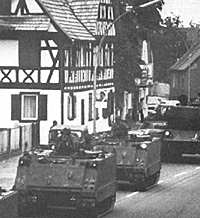 Advancing along these lines without becoming bogged down in cities and towns...
Advancing along these lines without becoming bogged down in cities and towns...
Doctrine must also take the potential battlefield environment into consideration. An analysis of the battlefield environment in Europe must include an examination of the terrain in West Germany. As previously discussed, the most credible scenario for a U.S. - Soviet conflict centers around a Soviet invasion of West Germany, so its terrain figures heavily into the plans and doctrine of each side.
West Germany is relatively urbanized. Planning an axis of advance along a major line of communications will always include several towns and cities. Advancing along these lines without becoming bogged down in cities and towns defended by dismounted infantry or territorial forces would prove very difficult. Small towns occur every few kilometers between the larger cities and are situated along roads and highways. Towns are even located along the low ground making it more difficult for defending units to disengage. The hills and ridges provide better cover for such withdrawals.
The hills in West Germany are usually covered with well- maintained forests. The trees may or may not allow vehicular traffic to penetrate the woods off the roads. Trees that prohibit vehicle movement due to their size and strength are referred to as hardwood.
Most such forested areas contain enough trails to be traversable by vehicles, however. High ground, covered by forest, is ideal for defensive positions. The hills and trees mask a unit's withdrawal, and allow for more concealed and covered positions. An additional benefit arises from the concealment of trees: the woods add greatly to a unit's camouflage from air reconnaissance.
The use of obstacles is particularly well-suited to West Germany. The roads through hardwood forests, bridges, urban areas, and narrow points along the road are all susceptible to the use of demolitions to create impassable obstacles. Covered with fire, these obstacles may create major problems for attacking units. Road cratering charges, explosives, and scatterable mines may be used to create obstacles.
The main communication routes in Western Europe are primarily the highways. With the massive amounts of ammunition needed for modern combat, proper transportation routes are mandatory. There's are many such routes in West Germany, with most oriented east-west. Some are built up on embankments or elevated; these will reduce the fields of fire of units in nearby positions. Additionally, built-up bridges over rivers are very vulnerable to destruction.
The U.S. has utilized this rolling terrain to its advantage with weapons like the AH-64 attack helicopter and the Copperhead guided artillery projectile which rely on hidden firing units and forward observers able to coordinate fire. The U.S. Air Force has developed the A-10 Thunderbolt as a European tank buster. Its style of flying is specifically suited to follow a valley until within range of its target, roll over a hill, fire, and roll back out of the enemy's line of fire.
Middle East
The other major battlefield envisioned as a potential area of conflict is the Middle East, which would switch the battlefield from rolling hills, forest, and urban sprawl to the desert. The possible scenarios for a Middle East war are as varied as the situation is volatile. In the sixties, Egypt was a stout Soviet ally and Iran unshakably in the U.S. camp. Tomorrow may be different as well. Both sides have developed and practiced deployment to that trouble spot. The U.S., for example, has been conducting extensive operations in the Middle East annually.
Several major tactical considerations change in a desert battlefield. Ranges of ground weapons systems become more important due to the open spaces and minimal concealment. The environment is much harsher on soldiers and their equipment. Water becomes a supply consideration of major importance. Air power will dominate a desert war if one side can achieve air superiority. Air defenses or friendly aircraft must neutralize enemy air or the ground forces will be savaged - on a desert floor there is no place to hide from attacking aircraft.
Tactics for fighting in a desert have to be modified and will produce a variation on the army's doctrine: for example, the distance between elements will greatly increase, but the basic operational doctrine will remain the same.
More Modern Battle Doctrine
- Introduction
Objectives and Doctrine
Weapons and Doctrine
Terrain and Doctrine
Soviet Army Doctrine
US Doctrine: AirLand Battle
Back to Table of Contents: CounterAttack #1
To CounterAttack List of Issues
To MagWeb Master Magazine List
© Copyright 1987 by Pacific Rim Publishing Company.
This article appears in MagWeb (Magazine Web) on the Internet World Wide Web.
Other military history articles and gaming articles are available at http://www.magweb.com